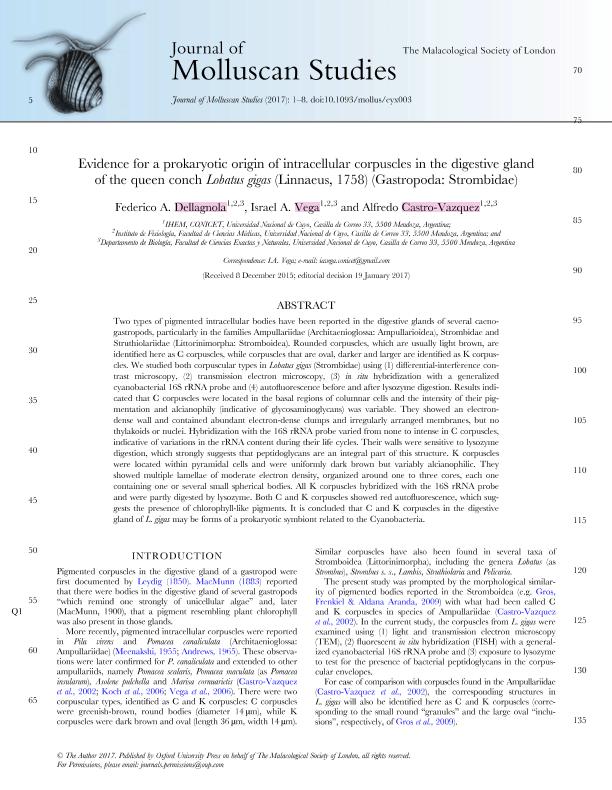Mostrar el registro sencillo del ítem
dc.contributor.author
Dell Agnola, Federico Agustín

dc.contributor.author
Vega, Israel Aníbal

dc.contributor.author
Castro Vazquez, Alfredo Juan

dc.date.available
2018-06-19T19:07:13Z
dc.date.issued
2017-05
dc.identifier.citation
Dell Agnola, Federico Agustín; Vega, Israel Aníbal; Castro Vazquez, Alfredo Juan; Evidence for a prokaryotic origin of intracellular corpuscles in the digestive gland of the queen conch Lobatus gigas (Linnaeus, 1758) (Gastropoda: Strombidae); Oxford University Press; Journal of Molluscan Studies; 83; 2; 5-2017; 186-193
dc.identifier.issn
0260-1230
dc.identifier.uri
http://hdl.handle.net/11336/49392
dc.description.abstract
Two types of pigmented intracellular bodies have been reported in the digestive glands of several caenogastropods, particularly in the families Ampullariidae (Architaenioglossa: Ampullarioidea), Strombidae and Struthiolariidae (Littorinimorpha: Stromboidea). Rounded corpuscles, which are usually light brown, are identified here as C corpuscles, while corpuscles that are oval, darker and larger are identified as K corpuscles. We studied both corpuscular types in Lobatus gigas (Strombidae) using (1) differential-interference contrast microscopy, (2) transmission electron microscopy, (3) in situ hybridization with a generalized cyanobacterial 16S rRNA probe and (4) autofluorescence before and after lysozyme digestion. Results indicated that C corpuscles were located in the basal regions of columnar cells and the intensity of their pigmentation and alcianophily (indicative of glycosaminoglycans) was variable. They showed an electrondense wall and contained abundant electron-dense clumps and irregularly arranged membranes, but no thylakoids or nuclei. Hybridization with the 16S rRNA probe varied from none to intense in C corpuscles, indicative of variations in the rRNA content during their life cycles. Their walls were sensitive to lysozyme digestion, which strongly suggests that peptidoglycans are an integral part of this structure. K corpuscles were located within pyramidal cells and were uniformly dark brown but variably alcianophilic. They showed multiple lamellae of moderate electron density, organized around one to three cores, each one containing one or several small spherical bodies. All K corpuscles hybridized with the 16S rRNA probe and were partly digested by lysozyme. Both C and K corpuscles showed red autofluorescence, which suggests the presence of chlorophyll-like pigments. It is concluded that C and K corpuscles in the digestive gland of L. gigas may be forms of a prokaryotic symbiont related to the Cyanobacteria.
dc.format
application/pdf
dc.language.iso
eng
dc.publisher
Oxford University Press

dc.rights
info:eu-repo/semantics/openAccess
dc.rights.uri
https://creativecommons.org/licenses/by-nc-sa/2.5/ar/
dc.subject
Endosymbiosis
dc.subject
Digestive Gland
dc.subject
Littorinimorpha
dc.subject
Strombidae
dc.subject.classification
Otras Ciencias Biológicas

dc.subject.classification
Ciencias Biológicas

dc.subject.classification
CIENCIAS NATURALES Y EXACTAS

dc.title
Evidence for a prokaryotic origin of intracellular corpuscles in the digestive gland of the queen conch Lobatus gigas (Linnaeus, 1758) (Gastropoda: Strombidae)
dc.type
info:eu-repo/semantics/article
dc.type
info:ar-repo/semantics/artículo
dc.type
info:eu-repo/semantics/publishedVersion
dc.date.updated
2018-06-13T16:54:08Z
dc.journal.volume
83
dc.journal.number
2
dc.journal.pagination
186-193
dc.journal.pais
Reino Unido

dc.journal.ciudad
Oxford
dc.description.fil
Fil: Dell Agnola, Federico Agustín. Consejo Nacional de Investigaciones Científicas y Técnicas. Centro Científico Tecnológico Conicet - Mendoza. Instituto de Histología y Embriología de Mendoza Dr. Mario H. Burgos. Universidad Nacional de Cuyo. Facultad de Cienicas Médicas. Instituto de Histología y Embriología de Mendoza Dr. Mario H. Burgos; Argentina. Universidad Nacional de Cuyo. Facultad de Ciencias Médicas; Argentina
dc.description.fil
Fil: Vega, Israel Aníbal. Consejo Nacional de Investigaciones Científicas y Técnicas. Centro Científico Tecnológico Conicet - Mendoza. Instituto de Histología y Embriología de Mendoza Dr. Mario H. Burgos. Universidad Nacional de Cuyo. Facultad de Cienicas Médicas. Instituto de Histología y Embriología de Mendoza Dr. Mario H. Burgos; Argentina
dc.description.fil
Fil: Castro Vazquez, Alfredo Juan. Consejo Nacional de Investigaciones Científicas y Técnicas. Centro Científico Tecnológico Conicet - Mendoza. Instituto de Histología y Embriología de Mendoza Dr. Mario H. Burgos. Universidad Nacional de Cuyo. Facultad de Cienicas Médicas. Instituto de Histología y Embriología de Mendoza Dr. Mario H. Burgos; Argentina
dc.journal.title
Journal of Molluscan Studies

dc.relation.alternativeid
info:eu-repo/semantics/altIdentifier/url/https://academic.oup.com/mollus/article/83/2/186/3053046
dc.relation.alternativeid
info:eu-repo/semantics/altIdentifier/doi/http://dx.doi.org/10.1093/mollus/eyx003
Archivos asociados
